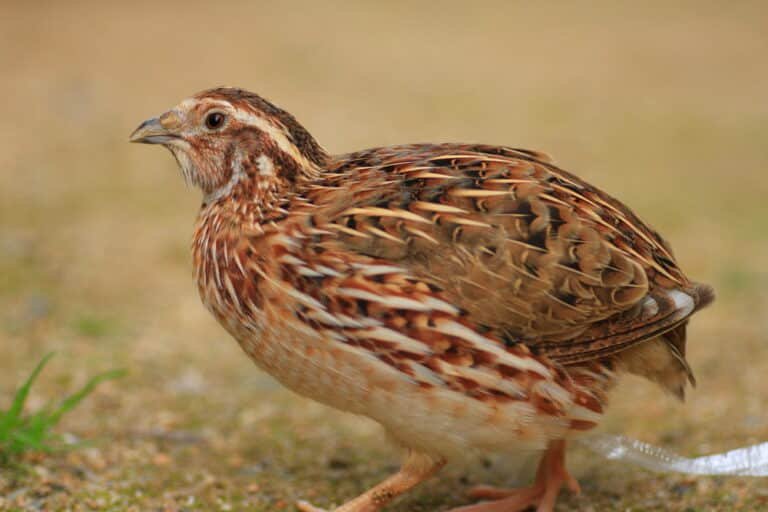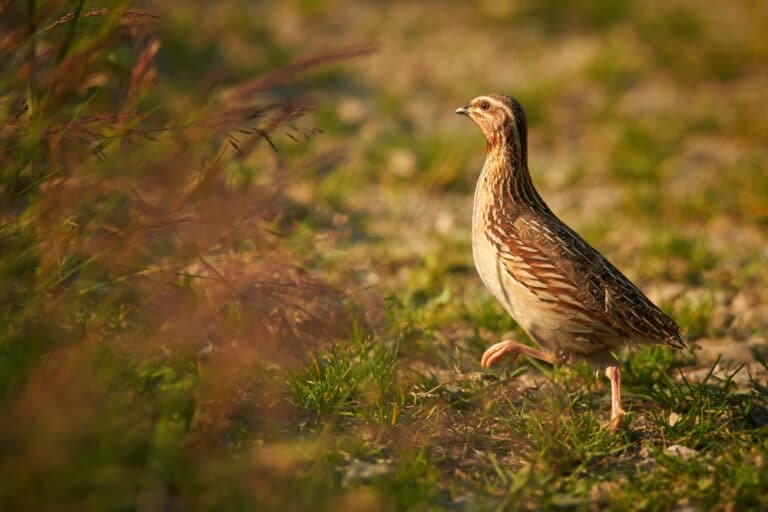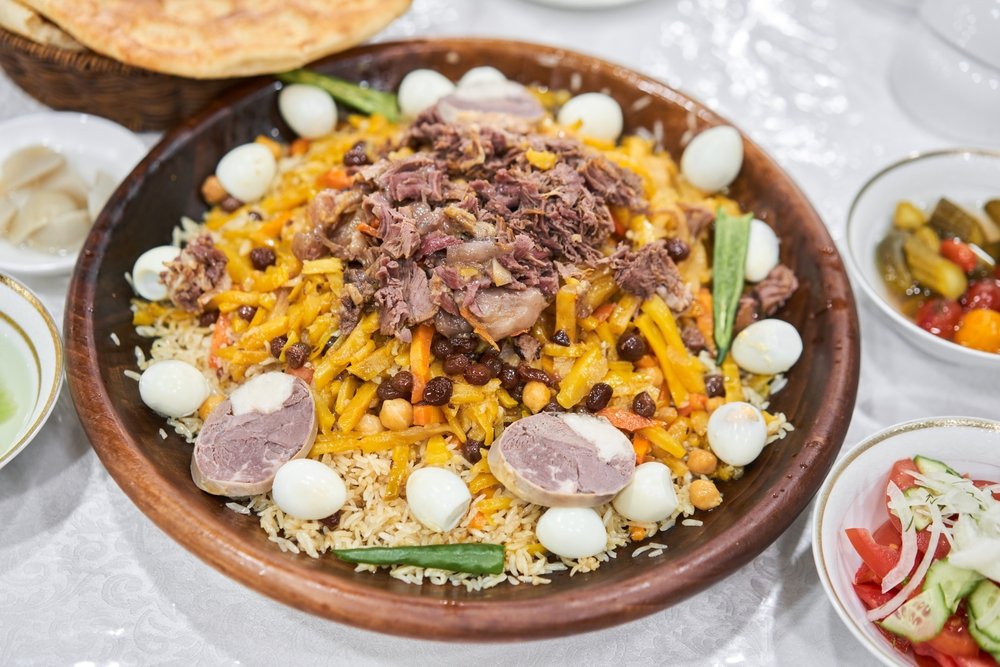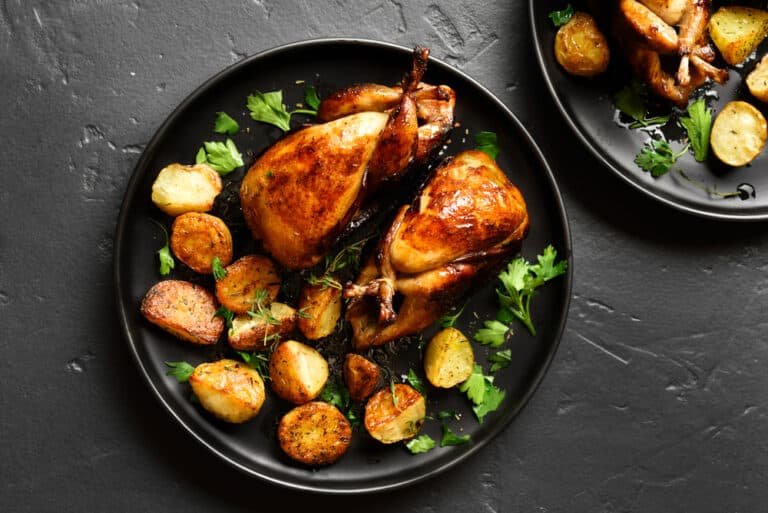Quail Chicks 101: Powerful Tips & Tricks to Raising Quail
Quail chicks, scientifically known as Coturnix coturnix, are the offspring of quail, small to medium-sized birds from the Phasianidae family. These adorable little creatures are characterized by their plump bodies, short beaks, and round heads. Quail chicks exhibit many striking colors, ranging from sandy browns and grays to vibrant yellows and whites.
Their tiny wings enable them to flutter about swiftly, while their sturdy legs allow quick movements on the ground. With an average weight of 7-10 grams at hatching, these diminutive yet resilient creatures possess remarkable survival skills from birth.
Importance and Popularity of Quail Chicks in the Poultry Industry
Quail chicks hold a significant position in the poultry industry due to their numerous advantages. Firstly, they are highly valued for their meat, which is sought after by many culinary enthusiasts for its delicate flavor and tender texture. In addition to being delicious, quail meat is also considered healthier than other poultry options as it contains lower cholesterol levels and saturated fat.
Secondly, quail eggs have gained immense popularity recently due to their nutritional benefits. These eggs are protein-rich and contain essential vitamins and minerals such as vitamin B12, iron, and selenium.
Moreover, quail have gained popularity among hobbyist farmers and urban dwellers seeking alternative ways of sustainable food production for several reasons, such as limited space requirements for raising them compared to other poultry species like chickens or ducks.
Additionally, quail reach maturity at an astonishingly fast rate—within six weeks—making them highly efficient in terms of egg production or meat yield. Their small size allows easier handling during breeding or rearing processes than larger bird species.
Quails are known for their adaptability, making them suitable for a wide range of climates and regions globally. Quail chicks are fascinating little creatures that have captured the attention and admiration of many individuals in the poultry industry.
Their unique characteristics, adorable appearance, and remarkable adaptability make them a valuable asset for commercial farming and small-scale backyard enthusiasts. With their versatile meat and highly nutritious eggs, quail chicks have earned their position as one of the most sought-after avian species in the modern agricultural landscape.
Overview of Quail Chicks
Species and breeds of quail chicks
Quail chicks belong to the bird family Phasianidae, genus Coturnix. Several species of quail are commonly raised, with the Japanese Quail (Coturnix japonica) being the most widespread. Other popular species include the California Quail (Callipepla californica) and the Gambel’s Quail.
Various breeds are developed within these species for specific traits such as egg production, meat quality, or ornamental purposes. Each species and breed of quail chick exhibits distinct characteristics and adaptability to different environments.
For instance, Japanese Quail are renowned for their remarkable egg-laying capabilities, producing small but nutritious eggs tailored for consumption. On the other hand, California Quail possess striking plumage patterns that make them a favorite among aviculture enthusiasts.
Physical appearance and distinguishing features
Quail chicks boast unique physical attributes that distinguish them from other avian species. They possess plump bodies covered in soft feathers ranging in colors from brownish hues to vibrant combinations of white, tan, black, and gray marks.
These markings often camouflage against predators while blending seamlessly with their natural surroundings. One distinguished characteristic of quail chicks is their compact size.
They typically measure around 4-6 inches in height and weigh between 4-7 ounces when fully grown. Their beaks are short yet sturdy, adapted for pecking through soil or vegetation for food.
Life cycle and growth stages
The life cycle of a quail chick encompasses various developmental stages from hatching to maturity. It begins with 17-18 days incubation for most quail species. During this time, the eggs are kept warm and humid, either through natural brooding or artificial means using incubators.
Once hatched, quail chicks enter the brooding stage, which typically lasts 2-3 weeks. This phase requires a controlled and warm environment to ensure proper growth.
Brooders with heat lamps or heating pads maintain an optimal temperature of around 95-100°F. Following the brooding stage, quail chicks progress into the growing stage, transitioning from starter feed to grower feed.
They undergo rapid physical development during this period, reaching maturity in about 6-8 weeks. It is worth noting that different species and breeds may exhibit slightly varying growth rates and overall developmental timelines.
Understanding the various species and breeds of quail chicks, their physical attributes, and their life cycle is crucial for successful rearing and management practices. By providing appropriate care tailored to their unique needs at each growth stage, quail enthusiasts can ensure healthy and thriving populations of these fascinating avian creatures.
Habitat and Environment
Natural habitat of quail in the wild
Quails, including quail chicks, are known to inhabit diverse ecosystems across the globe. In the wild, these small game birds can be found in various habitats, such as grasslands, woodlands, and agricultural areas.
They are remarkably adaptable to different terrain types, including deserts and marshes. Quails prefer areas with dense vegetation that provides cover and protection from predators.
They are particularly fond of habitats with a mixture of short grasses for foraging and taller vegetation for nesting purposes. These adaptable birds are also known to thrive in both temperate and tropical regions.
Adaptability to different climates and regions
Quail chicks have an impressive ability to adapt to various climates and regions worldwide. While some species of quail prefer warmer climates in Mediterranean or subtropical regions, others can withstand harsher conditions in colder areas like northern Europe or North America. Their ability to regulate their body temperature enables them to survive extreme weather conditions such as heatwaves or cold spells.
Furthermore, quail chicks exhibit notable resilience in adapting their foraging habits according to the available food sources within their environment. They have been observed adjusting their diets based on seasonal or geographical variations.
Housing requirements for raising quail chicks domestically
Creating an ideal housing environment is crucial when raising quail chicks domestically. Social birds require adequate space that allows them freedom of movement while minimizing stress levels caused by overcrowding. A suitable enclosure should ideally include both indoor and outdoor spaces.
The indoor shelter should be well-ventilated with proper insulation against extreme temperatures. Flooring should be covered with absorbent bedding material like straw or wood shavings that provide comfort while facilitating easy cleaning.
Outdoor runs should be securely fenced to protect quail chicks from predators. The enclosure should have a covered area to provide shade and shelter when needed.
Additionally, it is essential to provide access to clean drinking water through spill-proof containers and appropriate feeders designed to minimize wastage. By meeting these housing requirements, quail chicks can thrive in a domestic setting, ensuring their comfort and overall well-being.
Diet and Nutrition
Dietary Preferences of Quail Chicks in the Wild
In their natural habitat, quail chicks exhibit diverse dietary preferences. They are considered omnivores, meaning they consume plant matter and small insects or invertebrates. Quail chicks forage on the ground, pecking at seeds, grains, berries, and tender shoots of plants.
They also have a keen eye for insects like beetles, ants, grasshoppers, and worms. This varied diet helps them acquire the necessary nutrients for their growth and development.
Nutritional Requirements for Optimal Growth and Development
To promote optimal growth and development in quail chicks under domestication or farming conditions, providing them with a balanced diet is crucial to meet their nutritional requirements.
The key nutrients required include proteins, carbohydrates, fats, vitamins, minerals, and water. These nutrients play vital roles in various bodily functions such as muscle development, bone strength formation, energy production, and overall health maintenance.
Protein-rich Diet for Muscle Development
Proteins are essential macronutrients that are crucial for muscle development in quail chicks. Adequate protein intake enables proper feather growth and ensures strong flight muscles for survival.
Incorporating high-quality protein sources like mealworms or crickets into their diet is highly recommended. Additionally, providing commercial chick starter feed fortified with proteins derived from soybean meal or fish meal can help meet their increased protein needs during the early stages of life.
Calcium Supplementation for Strong Bones
Calcium plays a vital role in promoting strong bones in growing quail chicks. It is especially important during the early stages of life when skeletal development occurs rapidly. A calcium deficiency can lead to skeletal abnormalities like weak bones or deformities.
They must supplement their diet with calcium-rich sources to prevent such issues. Crushed oyster shells, ground eggshells, or commercially available calcium supplements can be mixed with their feed to ensure they receive adequate amounts of this mineral.
Vitamin-rich Foods for Overall Health
Quail chicks require sufficient vitamins to maintain proper metabolic functions and promote overall health. Vitamins A, D, E, and B complex vitamins are particularly important. These can be obtained through a balanced diet, including fresh greens like spinach, kale, or dandelion.
Additionally, providing them with high-quality commercial chick starter feeds fortified with essential vitamins is crucial in meeting their nutritional needs. Adequate vitamin intake helps support their immune system, vision development, and reproductive health.
Overall, the dietary preferences and nutritional requirements of quail chicks are essential factors to consider when raising them either in domestic settings or on a farming scale. A well-balanced diet that includes protein-rich foods for muscle development, calcium supplementation for strong bones, and vitamin-rich foods for overall health will contribute significantly to these delightful avian creatures’ optimal growth and well-being.
Reproduction and Breeding Patterns
Mating rituals and courtship behaviors
Quail are known for their intricate mating rituals and courtship behaviors. These rituals are essential for attracting a suitable mate and ensuring successful reproduction.
Male quail, also known as cocks, engage in elaborate displays to showcase their fitness and attract the attention of females, referred to as hens. These displays involve a combination of vocalizations, posturing, and physical movements.
Male’s elaborate displays to attract females
Male quail put on impressive displays to captivate the attention of prospective mates. One common display is the “bobwhite call,” where the male produces a distinct whistle-like sound that serves as a territorial marker while signaling his availability for mating. Furthermore, males engage in physical exhibitions by puffing up their chests, spreading their wings, and rapidly vibrating their bodies – all designed to catch the eye of nearby females.
Female’s role in selecting a mate based on displays
In the world of quail courtship, it is the female who holds the power when it comes to mate selection. Females assess potential mates based on various factors exhibited during male displays.
They observe both vocalizations and physical performances closely before making their choice. The quality of these displays often reflects the genetic fitness of the males; therefore, females tend to favor those with stronger or more impressive displays as potential partners.
Incubation period, nest building, and hatching process
Once a female has selected her mate, they commence nesting activities together. Quails typically build nests on the ground using materials such as leaves or twigs to create shallow depressions lined with soft vegetation or feathers within dense vegetation cover.
The female lays her eggs over several days until she has produced a clutch size ranging from 8-12 eggs on average, depending on the species. Following egg-laying, the female begins incubating the eggs.
The incubation period for quail chicks lasts approximately 17-24 days, during which time the female remains dedicated to maintaining optimal conditions for embryo development. She diligently regulates the temperature and humidity within the nest by adjusting her position and occasionally adding or removing nesting materials.
As the incubation period nears its end, the chicks begin to hatch. The hatching process can take several hours or even days as each chick meticulously pecks its way out of its shell using an egg tooth—an adaptation located near its beak specifically for this purpose.
Once hatched, quail chicks are precocial, meaning they are relatively independent from birth and can start moving around and feeding themselves shortly after emerging from their shells.
By understanding quail chicks’ intricate reproduction and breeding patterns, we gain a deeper appreciation for their evolutionary adaptations and behaviors in ensuring their species’ successful reproduction and survival.
Raising Quail Chicks at Home or Farming Scale
Hatching eggs artificially using incubators
Artificial incubation using specialized equipment such as incubators has become increasingly popular when hatching quail chicks. This method controls temperature, humidity, and turning requirements during incubation.
Incubators simulate the natural conditions of a mother quail sitting on her eggs, ensuring a higher hatch rate and overall success in chick development. Choosing an appropriate-sized incubator based on your desired capacity and ensuring reliable temperature control capabilities is essential.
Temperature, humidity, and turning requirements during incubation
Maintaining optimal temperature and humidity levels is crucial for successful egg incubation. The recommended temperature inside the incubator for quail chicks should be around 99-100 degrees Fahrenheit (37-38 degrees Celsius).
Humidity levels should be carefully monitored and maintained between 50-55% during the first 14 days of incubation and then increased to 60-65% for the remaining days until hatching. Additionally, turning eggs is necessary to prevent the embryo from sticking to the shell.
Quail eggs require gentle rotation at least thrice per day until day 14 of incubation when they should be left undisturbed until hatching. In many modern incubators, turning can be done manually or with an automatic egg-turner.
Caring for eggs during the incubation period
During the entire egg incubation duration, monitoring their progress closely is vital. Regularly check for cracked or damaged eggs, as they can negatively affect adjacent healthy ones.
Maintain cleanliness by removing any debris or contaminants from within the incubator. A separate container or tray under each batch of eggs is recommended to identify potential issues and easily minimize cross-contamination.
Brooding stage: Providing warmth, shelter, water, feed
Once the quail chicks have hatched, they enter the brooding stage, requiring specific care to ensure their well-being. Providing adequate warmth is crucial during this period. A brooder box with a heat lamp or heating pad can maintain a temperature of around 95-100 degrees Fahrenheit (35-38 degrees Celsius) in the first week.
The temperature should gradually decrease by five degrees each week until reaching ambient temperature at around six weeks old. In addition to warmth, shelter must be provided to protect the chicks from predators and adverse weather conditions.
A secure enclosure with appropriate bedding material, such as wood shavings or straw, will create a comfortable environment for them to grow and thrive. Clean water should always be available in shallow containers to prevent drowning, and a high-quality chick starter feed should be provided from day one.
Proper temperature control in the brooder box
Maintaining proper temperature within the brooder box is essential for the growth and health of quail chicks. To achieve this, it is recommended to use a thermometer placed at chick height within the enclosure. Adjusting the heat source (heat lamp or heating pad) based on its readings will help maintain an optimal temperature range throughout their development.
Importance of clean water supply
Clean water is vital for quail chick health and hydration. It is crucial to provide fresh water daily in shallow dishes that are easily accessible but not deep enough for them to drown in. Regularly clean these dishes and ensure that the water remains clean and free from contaminants, as dirty water can lead to various health issues among the chicks.
Growing stage: Transitioning from starter feed to grower feed
As quail chicks progress into their growing stage, typically around 6-8 weeks old, their nutritional needs change. Transitioning from a starter feed to a grower feed is essential to support their continued development and ensure proper feathering, bone growth, and muscle strength. The grower feed should have a slightly lower protein content than the starter feed but still contain essential nutrients for their overall well-being.
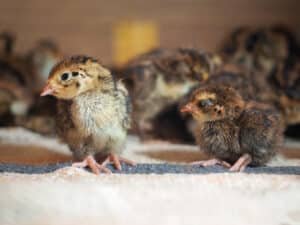
Conclusion
Raising quail chicks at home or on a farming scale can be immensely rewarding. With careful attention to hatching eggs using incubators, maintaining optimal temperature and humidity during incubation, providing proper care during the brooding stage, and transitioning to appropriate feed during the growing stage, you can experience the joy of watching these adorable creatures thrive.
Quail chicks offer learning opportunities and the potential for sustainable food production or simply the delight of having them as unique additions to your backyard. Embrace this journey enthusiastically and impart your newfound knowledge to others interested in raising quail chicks – an adventure that will leave you feeling fulfilled and inspired.

